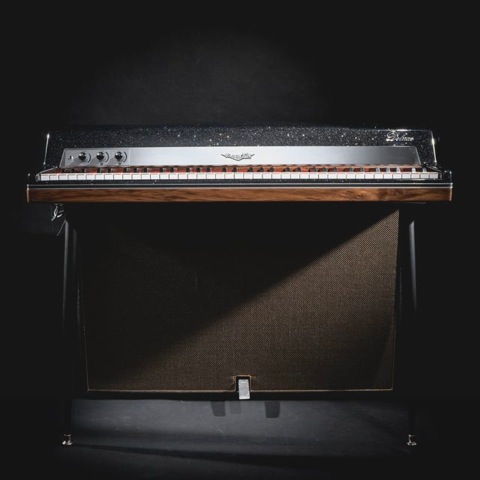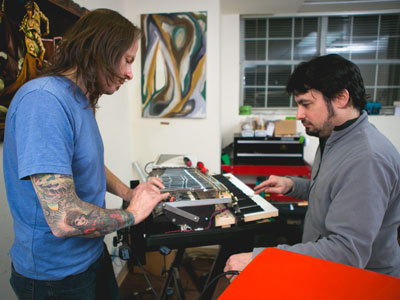Master craftsman and designers, Fred DiLeone and Chris Carroll, reveal the inside secrets of how they created their unique Vintage Vibe Electric Tine Piano
Vintage Vibe has been repairing and restoring classic Rhodes, Wurlitzer, and Clavinet keyboards since the late 1990s. In 2008, the company’s founder, Chris Carroll, along with master technician Fred DiLeone, embarked on a quest to build their own electro-mechanical keyboard in the style of the Rhodes, infusing it with their own ideas of improved performance, reduced weight, and customizable, sleek new looks. Today, Vintage Vibe has published the inside story of their adventure of creating a unique new analog instrument—an instrument embraced by some of the greatest musicians of our generation—the Vintage Vibe Electric Piano. Visit the Vintage Vibe website blog to read the complete epic tale: (http://bit.ly/Inside-Story-Vintage-Vibe-Pianos). Here are some highlights…
Chris Carroll describes the beginning of the process of creating their own electric piano, “It was a combination of ideas we had that was the impetus for the Vintage Vibe piano. I had been amassing a catalog of aftermarket parts for the vintage Rhodes renaissance that was starting to bloom. Fred DiLeone on the other hand had already started chopping Rhodes pianos and making smaller versions like his custom 32-note suitcase model. We would work in the shop together by day, and by night drink Coronas while working and talking about everything having to do with electric pianos.”
“The original idea in my mind at the time was to modify vintage instruments,” Fred DiLeone adds. “Chris began to throw around the idea of building an entirely new piano. I originally thought it was a bit optimistic, but soon realized that was the path to go down!”
At the time, Vintage Vibe was restoring Donald Fagen’s three Rhodes 88 pianos and digging even deeper into what really made the instrument play and sound its best. They even began video taping performances using each restoration and listening back to the sound, then tweaking the pianos to fix anomalous notes that stood out, “We started demanding more from ourselves and we really began learning to go deep and understand reasons. All in all, it was a very optimistic time with the good economy in early 2008 and we also had the excess energy of youth,” Carroll says.
One of the biggest goals was to create a lighter instrument than the classic behemoth Rhodes. “We had a lot of parts already made and in stock, ironically, we would come to find out that we didn’t have the most important or hardest parts to manufacture, including the tines, the lid, the sustain mechanism, and the chassis.” Carroll continues, “Redesigning the structural integrity without using a big plywood box to house the piano was super-important to shed the bulk of the weight.” The company was very successful in its redesign and today’s 73-note Vintage Vibe Electric Piano weighs in at only 60 pounds, less than half of a 1970s Rhodes.
Although the company now utilizes one of the original Torrington Swaging Machines to make the tines, “Just because you have Michelangelo’s chisels doesn’t mean you can carve David,” quips DiLeone, pointing out there’s a lot to the process of making a perfect tine. “The original tine secret recipe was a very deceptive puzzle. It took many years and more money than I care to admit to crack the code fully,” Carroll adds. “There is a strict recipe to follow with a huge number of variables. If any one variable is off, so is your tine. Vintage Vibe tines are all about technique and secrets we developed.”
“The first Vintage Vibe prototypes were built from Rhodes parts that I had collected throughout the years,” DiLeone explains. “We assembled the initial prototype on a flat board standing in for the chassis. Once a chassis design was finalized, the original prototype was reassembled on that. Serial #001 then became my gigging axe, and is still in service today!”
“The first Vintage Vibe piano that was offered to the public to checkout and play was a 64-key model with the serial #002,” says Carroll. “This was not the second piano, but it was the first prototype the public got to play. Going to NAMM in 2011 was our official launch of the Vintage Vibe Piano. I still have that piano in the shop.”
“Designing the lid without the use of computer software or engineering tools was difficult. We literally used old lids and cut them down and glued them together,” recalls Carroll. “We wanted to go as small as possible, so the Wurlitzer 200 lid size represented the kind of styling we were thinking of. I wanted our piano to be recognizable as its own entity,” adds DiLeone. “That’s where the ‘VW Beetle bonnet’ scoop motif came in, we tweaked it to represent a “V” for obvious reasons: Vintage Vibe!”
Carroll states, “We have spent the last 8 years trying to turn others on to the magic and beauty of our electric piano. One-by-one they are starting to gather into the Vintage Vibe light. The current list of users is a Who’s Who of music giants. When we first started we couldn’t catch a cab, now we can’t catch our breath.”

The Vintage Vibe blog delves into the making of their electric piano, covers more than 10 years and the many details of the process, and collects historic photos and videos. The blog is a must-read for any keyboard professional or enthusiast, whether they currently own a Rhodes, Wurlitzer, or a Vintage Vibe piano—or are planning on having one of their own some day. See: http://bit.ly/Inside-Story-Vintage-Vibe-Pianos
About Vintage Vibe
With its team of master technicians, fabricators, and assemblers, Vintage Vibe is the world leader in repair and restoration of electro-mechanical keyboards and the only manufacturer of a complete line of replacement parts for Rhodes and Wurlitzer pianos as well as Hohner Clavinets. This unique combination of expertise, talent, and resources led the company to begin manufacturing its own electro-mechanical piano designs in 2009, the Vintage Vibe Piano™ and the Vibanet™ — modern takes on Rhodes and Clavinet keyboards. Since then, an ever-expanding group of the worlds’ top artists have been drawn to use Vintage Vibe instruments for recording and performance. For more information on Vintage Vibe keyboards and repair and restoration services, please visit http://www.vintagevibe.com or call 1-(973)-989-2178.
Vintage Vibe Piano and Vibanet are trademarks of Vintage Vibe. All other trademarks are the property of their respective holders. Description and specifications are subject to change without notice








